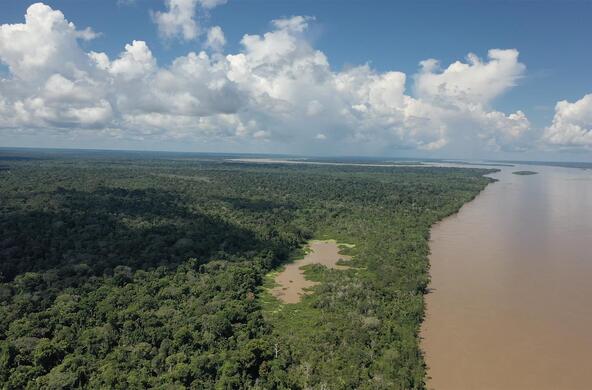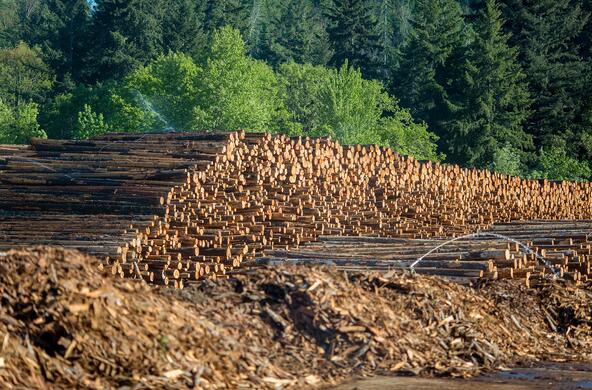An advisory panel to New York’s Climate Action Council is considering how forests, forestry and harvested wood products could play a role in meeting the state’s climate goals. A broad discussion on Monday could be the jumping off point to significant policy recommendations affecting the Adirondack Park.
The effort stems from the Climate Leadership and Community Protection Act, legislation passed in 2019 that requires the state to reduce its greenhouse gas emissions 40% by 2030 and 85% by 2050. To achieve these milestones, the Climate Action Council is charged with developing a planning document filled with strategies.
But with a number of industries and sectors involved in this work, the council has several advisory groups focused on specific topics. One is the Agriculture and Forestry Advisory Panel, chaired by Richard Ball, commissioner of the state Department of Agriculture and Markets.
The panel zeroed in on forests during a virtual meeting on Monday. Ball told panelists to consider “cost, policy, incentive structures, workforce development and threats and barriers to adoption of those ideas.”
Michelle Brown, a conservation scientist with the Nature Conservancy, said there are about 18.6 million acres of forest in the state, about 75% of which is privately owned. About 190,000 forest owners have at least 10 acres. New York’s forests sequester about 24.5 million metric tons of carbon per year, Brown said, but that number does not consider harvesting wood products.
Brown gave an overview of an ongoing study that she, the Cary Institute of Ecosystem Studies, the University of New Hampshire and other partners are working on to project carbon storage and sequestration based on a harvested ecosystem like the Adirondacks. The study will project 50 years into the future and 140 years in to the future, accounting for changes in carbon stocks and emissions for forests and forest products. It will also account for the exchange of fossil fuel emissions.
Overall recommendations Brown suggested to the panel include protecting existing forests, increasing the productivity of forestlands and restoring and establishing new forests. Within those categories, Brown provided more detailed suggestions like:
- Developing incentives and regulations to keep forests from being converted to something else;
- Reducing barriers for landowners to enroll in tax relief programs;
- Addressing threats to forests including deer, invasive species and improper management;
- Focusing forest harvests on durable wood products, which are better at sequestering carbon for longer periods of time; and
- Expanding the use of reforestation programs.
John Bartow, executive director of Empire State Forest Products Association, said many of his colleagues believe projected declines in carbon sequestration are due to aging forests, which they believe don’t take as much carbon dioxide out of the atmosphere as new trees.
Brown pointed to data from the Forest Inventory Analysis, which is a program by the U.S. Department of Agriculture’s Forest Service.
“FIA data do show that reducing biomass from where we are now will not increase the rate of sequestration,” Brown said. “I think there’s data out there that shows going backwards, reducing stocks on our forests, are not going to increase rates the way we think.”
Ned Sullivan, president of the environmental group Scenic Hudson, asked Brown how much of a threat herbivores are to carbon storage and sequestration, as well as pests and pathogens.
Brown said since New York is a global trading hub, the state has one of the highest rates of pest infestations, which are doing significant damage to trees. She referenced the latest find of the invasive hemlock woolly adelgid, a bug from Asia, currently feasting on at least 250 acres of hemlocks on the eastern side of Lake George.
“On the herbivory front, deer are having a major impact on our forest,” Brown added. “A full 15% of FIA (Forest Inventory Analsysis) plots had no seedlings or saplings, which is a large number. So yes, deer are a problem, and I think there’s a variety of strategies we could talk about.”
Peter Innes, natural resources supervisor for the state Department of Environmental Conservation, also presented proposed strategies to the advisory panel.
One of the biggest deterrents to owning and maintaining forests, Innes said, is taxes. While there are several programs focused on forestry stewardship, Innes and others on the panel said many landowners don’t know about them. In addition to increasing public knowledge about what is available, Innes suggested reforming real property tax assessments statewide, increasing financing options for improved forestry and monetizing forest carbon on private and publicly owned forests.
Other points Innes suggested included:
- Developing regulations and incentives to ensure no new loss of forestland;
- Developing regulations and incentives to report harvests and harvested wood products;
- Creating incentives for manufacturing state-grown wood products; and
- Increasing tree cover in urban areas.
Tom Gerow, general manager of Wagner Lumber Co., said he understood the group needs to consider all options, but “anytime regulations are brought up, the hairs on the back of my neck go up.”
Gerow also pointed out to the group that a “forester” is not a state licensed position. Members of the group talked about how it can be difficult to describe the benefits of hiring a forester to a property owner, when there’s no consistency and no state program.
The group also discussed doing more with wood waste like chips, sawdust and bark. Gerow said chips and pulpwood are used to heat facilities. The DEC, State Police and Adirondack Park Agency, for example, heat some of their offices in Ray Brook with wood pellets.
“All of those are displacing the use of fossil fuels,” Gerow said.
Innes said using wood product waste will be an important aspect to consider.
“It has multiple benefits because you have to utilize it to have a viable forest economy, but it also supplements, mitigates the fossil fuel aspect.”
Ball said there were “a tremendous number of ideas here.” The panel is divied up further into sub-groups and will continue to discuss ideas.
To learn more about the advisory panels, view meeting minutes and presentations, go to https://climate.ny.gov/Advisory-Panel/Meetings-and-Materials.






